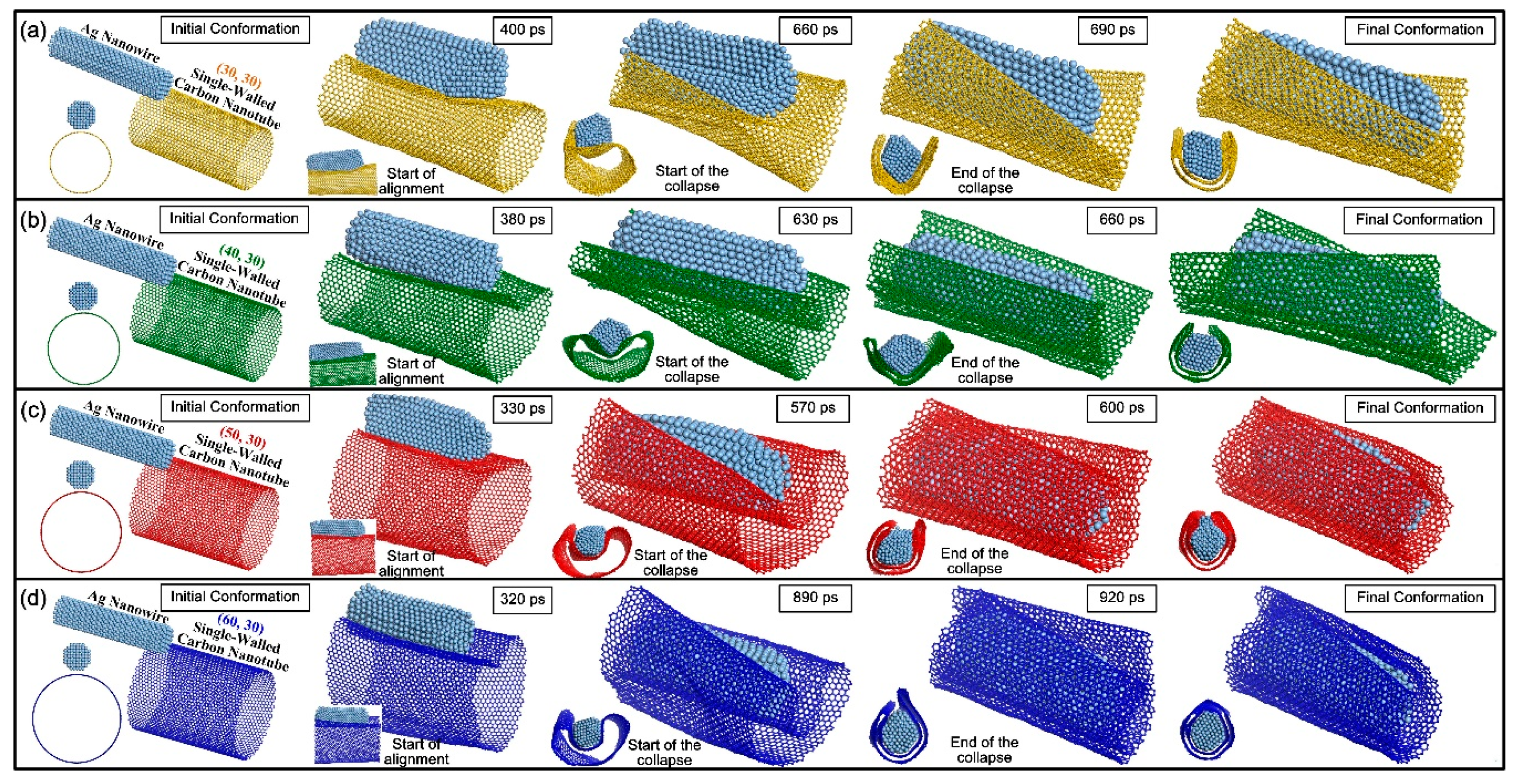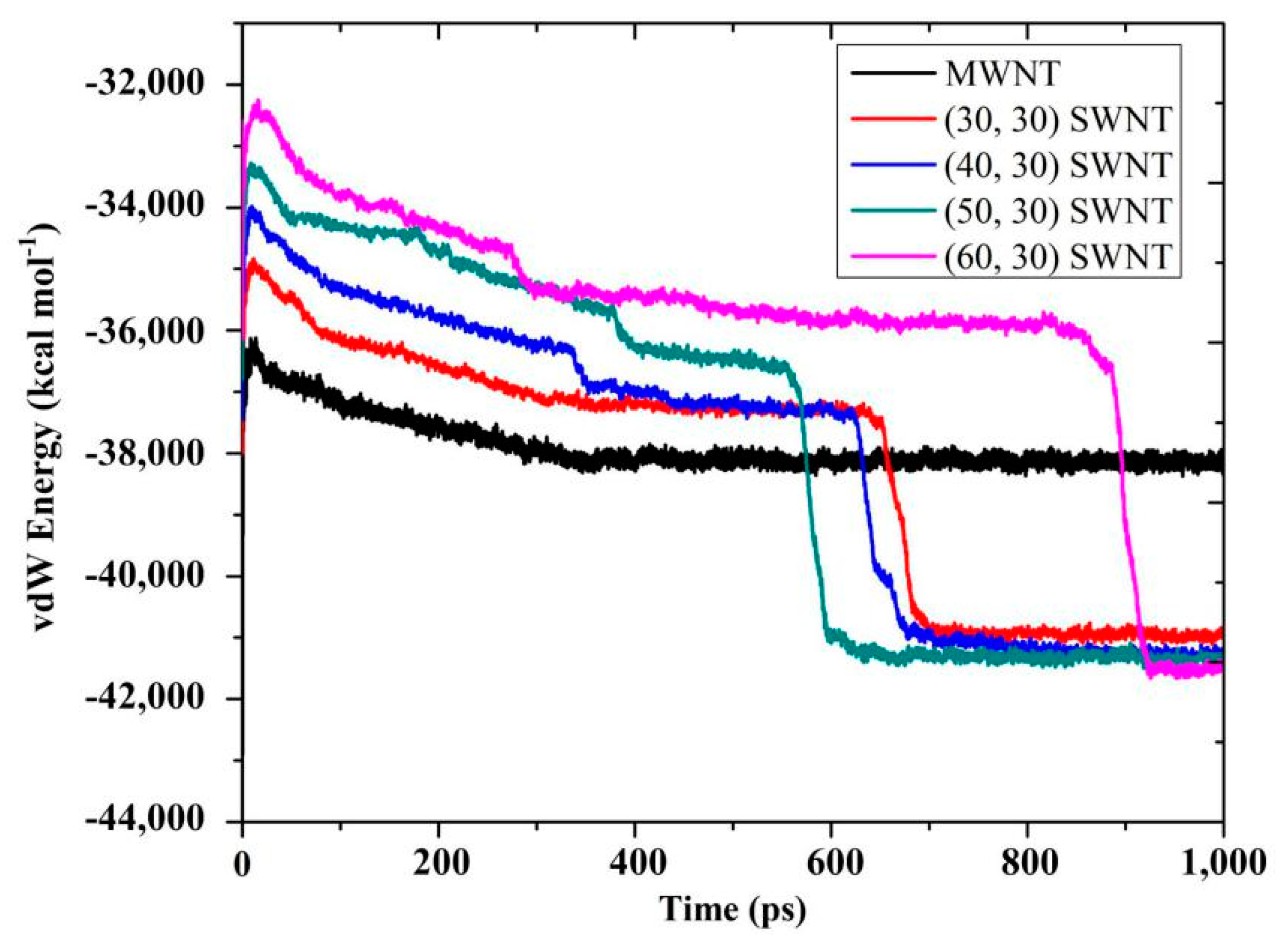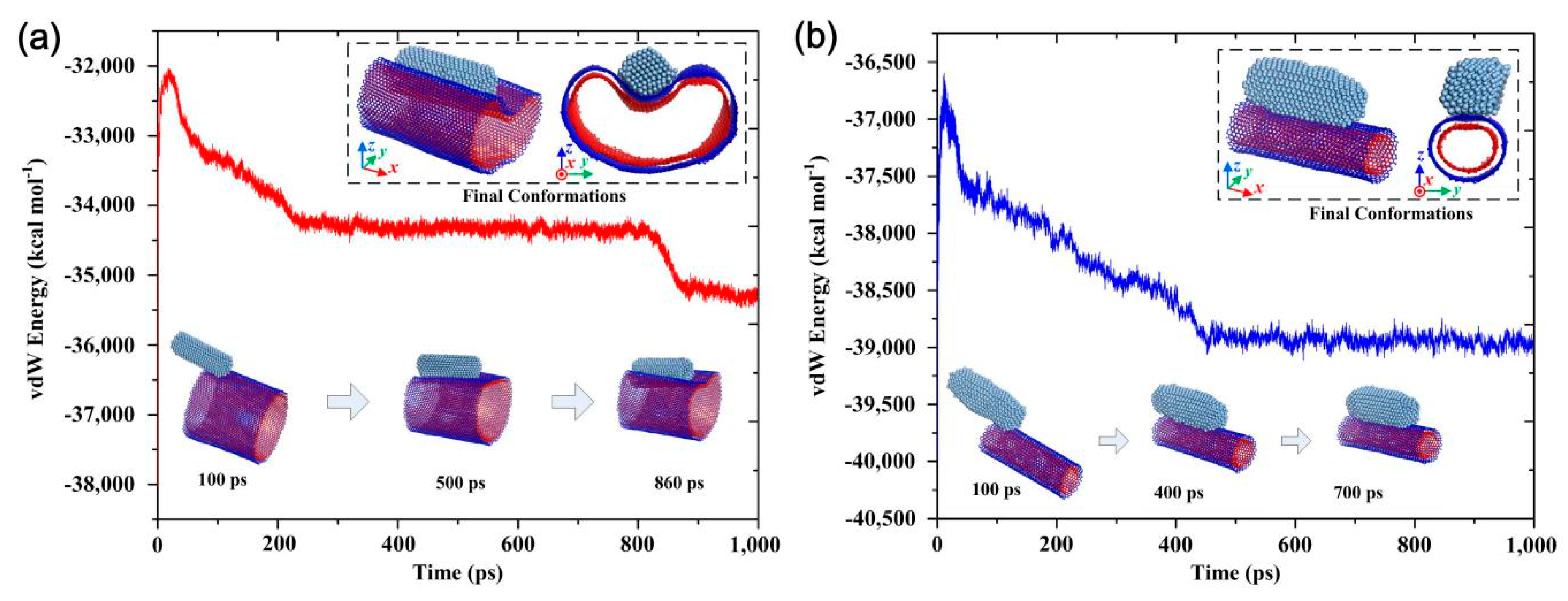Interfacial Contact Behavior between CNTs and AgNW with Molecular Dynamics Simulation
Abstract
1. Introduction
2. Simulation Methods
3. Results and Discussion
4. Conclusions
Supplementary Materials
Author Contributions
Funding
Conflicts of Interest
References
- De Volder, M.F.L.; Tawfick, S.H.; Baughman, R.H.; Hart, A.J. Carbon Nanotubes: Present and Future Commercial Applications. Science 2013, 339, 535–539. [Google Scholar] [CrossRef] [PubMed]
- Berman, D.; Krim, J. Surface Science, MEMS and NEMS: Progress and Opportunities for Surface Science Research Performed on, or by, Microdevices. Prog. Surf. Sci. 2013, 88, 171–211. [Google Scholar] [CrossRef]
- Zhong, D.; Zhang, Z.; Ding, L.; Han, J.; Xiao, M.; Si, J.; Xu, L.; Qiu, C.; Peng, L. Gigahertz Integrated Circuits based on Carbon Nanotube Films. Nat. Electron. 2018, 1, 40–45. [Google Scholar] [CrossRef]
- Zhao, C.; Zhong, D.; Han, J.; Liu, L.; Zhang, Z.; Peng, L. Exploring the Performance Limit of Carbon Nanotube Network Film Field-Effect Transistors for Digital Integrated Circuit Application. Adv. Funct. Mater. 2019, 29, 1808574. [Google Scholar] [CrossRef]
- Zhang, J.; Cui, J.; Wang, X.; Wang, W.; Mei, X.; Yi, P.; Yang, X.; He, X. Recent Progress in the Preparation of Horizontally Ordered Carbon Nanotube Assemblies from Solution. Phys. Status Solidi A 2018, 215, 1700719. [Google Scholar] [CrossRef]
- Ceyhan, A.; Naeemi, A. Cu Interconnect Limitations and Opportunities for SWNT Interconnects at the End of the Roadmap. IEEE Trans. Electron Devices 2013, 60, 374–382. [Google Scholar] [CrossRef]
- Cui, J.; Cheng, Y.; Zhang, J.; Mei, H.; Wang, X. Femtosecond Laser Irradiation of Carbon Nanotubes to Metal Electrodes. Appl. Sci. 2019, 9, 476. [Google Scholar] [CrossRef]
- Giacalone, F.; Campisciano, V.; Calabrese, C.; Parola, V.L.; Syrgiannis, Z.; Prato, M.; Gruttadauria, M. Single-Walled Carbon Nanotube-Polyamidoamine Dendrime Hybrids for Heterogeneous Catalysis. ACS Nano 2016, 10, 4627–4636. [Google Scholar] [CrossRef]
- Zhou, H.; Han, G. One-Step Fabrication of Heterogeneous Conducting Polymers-Coated Graphene Oxide/Carbon Nanotubes Composite Films for High-Performance Supercapacitors. Electrochim. Acta 2016, 192, 448–455. [Google Scholar] [CrossRef]
- Pyo, S.; Kim, W.; Jung, H.; Choi, J.; Kim, J. Heterogeneous Integration of Carbon-Nanotube–Graphene for High-Performance, Flexible, and Transparent Photodetectors. Small 2017, 13, 1700918. [Google Scholar] [CrossRef]
- Blackburn, J.L.; Ferguson, A.J.; Cho, C.; Grunlan, J.C. Carbon-Nanotube-Based Thermoelectric Materials and Devices. Adv. Mater. 2018, 30, 1704386. [Google Scholar] [CrossRef] [PubMed]
- Abidin, M.S.Z.; Herceg, T.; Greenhalgh, E.S.; Shaffer, M.; Bismarch, A. Enhanced fracture toughness of hierarchical carbon nanotube reinforced carbon fibre epoxy composites with engineered matrix microstructure. Compos. Sci. Technol. 2019, 170, 85–92. [Google Scholar] [CrossRef]
- Ruoff, R.S.; Tersoff, J.; Lorents, D.C.; Subramoney, S.; Chan, B. Radial deformation of carbon nanotubes by van der Waals forces. Nature 1993, 364, 514–516. [Google Scholar] [CrossRef]
- Chopra, N.G.; Benedict, L.X.; Crespi, V.H.; Cohen, M.L.; Louie, S.G.; Zettl, A. Fully Collapsed Carbon Nanotubes. Nature 1995, 377, 135–138. [Google Scholar] [CrossRef]
- Yan, K.; Xue, Q.; Zheng, Q.; Xia, D.; Chen, H.; Xie, J. Radial Collapse of Single-Walled Carbon Nanotubes Induced by the Cu2O surface. J. Phys. Chem. C 2009, 113, 3120–3126. [Google Scholar] [CrossRef]
- Xie, J.; Xue, Q.; Yan, K.; Chen, H.; Xia, D.; Dong, M. Chemical Modification: An Effective Way of Avoiding the Collapse of SWNTs on Al Surface Revealed by Molecular Dynamics Simulations. J. Phys. Chem. C 2009, 113, 14747–14752. [Google Scholar] [CrossRef]
- Yan, K.; Xue, Q.; Xia, D.; Chen, H.; Xie, J.; Dong, M. The Core/Shell Composite Nanowires Produced by Self-Scrolling Carbon Nanotubes onto Copper Nanowires. ACS Nano 2009, 3, 2235–2240. [Google Scholar] [CrossRef]
- Chen, W.; Li, H.; He, Y. Theoretical Study of Core-Shell Composite Structure Made of Carbon Nanoring and Aluminum Nanowire. Phys. Chem. Chem. Phys. 2014, 16, 7907–7912. [Google Scholar] [CrossRef]
- Zhang, D.; Liu, Z.; Yang, H.; Liu, A. Molecular Dynamics Study of Core-Shell Structure from Carbon Nanotube and Platinum Nanowire. Mol. Simul. 2018, 44, 648–652. [Google Scholar] [CrossRef]
- Zhang, D.; Yang, H.; Liu, Z.; Liu, A. Formation of Core-Shell Structure from Carbon Nanotube and Silver Nanowire. J. Alloys Compd. 2018, 765, 140–145. [Google Scholar] [CrossRef]
- Cui, J.; Zhang, J.; Wang, X.; Theogene, B.; Wang, W.; Tohmyoh, H.; He, X.; Mei, X. Atomic-Scale Simulation of the Contact Behaviour and Mechanism of the SWNT-AgNW Heterostructure. J. Phys. Chem. C 2019, 123, 19693–19703. [Google Scholar] [CrossRef]
- Cui, J.; Ren, X.; Mei, H.; Wang, X.; Zhang, J.; Fan, Z.; Wang, W.; Tohmyoh, H.; Mei, X. Molecular Dynamics Simulation Study on the Interfacial Contact Behavior between Single-Walled Carbon Nanotubes and Nanowires. Appl. Surf. Sci. 2020, 512, 145696. [Google Scholar] [CrossRef]
- Maple, J.R.; Thacher, T.S.; Dinur, U.; Hagler, A.T. Biosym Force Field Research Results in New Techniques for the Extraction of Inter-and Intramolecular Forces. Chem. Design Automat. News 1990, 5, 5–10. [Google Scholar]
- Sun, H. Force Field for Computation of configurational Energies, Structures, and Vibrational Frequencies of Aromatic Polyesters. J. Comput. Chem. 1994, 15, 752–768. [Google Scholar] [CrossRef]
- Peng, Z.; Ewig, C.S.; Hwang, M.J.; Waldman, M.; Hagler, A.T. Derivation of Class II Force Fields. 4. van der Waals Parameters of Alkali Metal Cations and Halide Anions. J. Phys. Chem. A 1997, 101, 7243–7252. [Google Scholar] [CrossRef]
- Zhang, J.; Cui, J.; Cheng, Y.; Wang, W.; He, X.; Mei, X. A molecular dynamics study on self-assembly of single-walled carbon nanotubes: From molecular morphology and binding energy. Adv. Mater. Interfaces 2019, 6, 1900983. [Google Scholar] [CrossRef]
- Zhang, J.; Cui, J.; Wei, F.; Wang, W.; He, X.; Mei, X. Investigating limiting factors for self-assembly of carbon nanotubes: A molecular dynamics simulation study. Appl. Surf. Sci. 2020, 504, 144397. [Google Scholar] [CrossRef]
- Liu, Y.; Chipot, C.; Shao, X.; Cai, W. Edge Effects Control Helical Wrapping of Carbon Nanotubes by Polysaccharides. Nanoscale 2012, 4, 2584–2589. [Google Scholar] [CrossRef]
- Lv, C.; Xue, Q.; Shan, M.; Jing, N.; Ling, C.; Zhou, X.; Jiao, Z.; Xing, W.; Yan, Z. Self-Assembly of Double Helical Nanostructures Inside Carbon Nanotubes. Nanoscale 2013, 5, 4191–4199. [Google Scholar] [CrossRef]
- Cui, J.; Zhang, J.; He, X.; Mei, X.; Wang, W.; Yang, X.; Xie, H.; Yang, L.; Wang, Y. Investigating interfacial contact configuration and behavior of single-walled carbon nanotube-based nanodevice with atomistic simulations. J. Nanopart. Res. 2017, 19, 110. [Google Scholar] [CrossRef]
- Cui, J.; Theogene, B.; Wang, X.; Mei, X.; Wang, W.; Wang, K. Molecular Dynamics Study of Nanojoining between Axially Positioned Ag Nanowires. Appl. Surf. Sci. 2016, 378, 57–62. [Google Scholar] [CrossRef]
- Cui, J.; Yang, L.; Zhou, L.; Wang, Y. Nanoscale Soldering of Axially Positioned Single-Walled Carbon Nanotubes: A Molecular Dynamics Simulation Study. ACS Appl. Mater. Interfaces 2014, 6, 2044–2050. [Google Scholar] [CrossRef] [PubMed]




© 2020 by the authors. Licensee MDPI, Basel, Switzerland. This article is an open access article distributed under the terms and conditions of the Creative Commons Attribution (CC BY) license (http://creativecommons.org/licenses/by/4.0/).
Share and Cite
Cui, J.; Mei, H.; Zhang, J.; Fan, Z.; Yang, J.; Wang, W.; Tohmyoh, H.; Mei, X. Interfacial Contact Behavior between CNTs and AgNW with Molecular Dynamics Simulation. Materials 2020, 13, 1290. https://doi.org/10.3390/ma13061290
Cui J, Mei H, Zhang J, Fan Z, Yang J, Wang W, Tohmyoh H, Mei X. Interfacial Contact Behavior between CNTs and AgNW with Molecular Dynamics Simulation. Materials. 2020; 13(6):1290. https://doi.org/10.3390/ma13061290
Chicago/Turabian StyleCui, Jianlei, Huanhuan Mei, Jianwei Zhang, Zhengjie Fan, Jun Yang, Wenjun Wang, Hironori Tohmyoh, and Xuesong Mei. 2020. "Interfacial Contact Behavior between CNTs and AgNW with Molecular Dynamics Simulation" Materials 13, no. 6: 1290. https://doi.org/10.3390/ma13061290
APA StyleCui, J., Mei, H., Zhang, J., Fan, Z., Yang, J., Wang, W., Tohmyoh, H., & Mei, X. (2020). Interfacial Contact Behavior between CNTs and AgNW with Molecular Dynamics Simulation. Materials, 13(6), 1290. https://doi.org/10.3390/ma13061290









